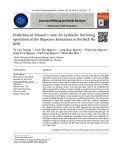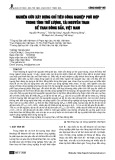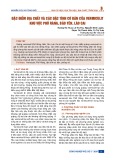
58 Journal of Mining and Earth Sciences, Vol 65, Issue 6 (2024) 58 - 69
Geological setting and gold mineralisation
characteristics at the Me Xi, Vinh Linh, Quang Tri,
Vietnam
Truong Xuan Le 1,2 *, Hai Thanh Tran 1, Khin Zaw 3, Thu Thi Le 1
1 Faculty of Geosciences and Geoengineering, Hanoi University of Mining and Geology, Hanoi, Vietnam
2Center for Excellence in Analysis and Experiment, Hanoi University of Mining and Geology, Hanoi, Vietnam
3CODES ARC Centre of Excellence in Ore Deposits, University of Tasmania, Private Bag 126, Hobart,
Tasmania 7001, Australia
ARTICLE INFO
ABSTRACT
Article history:
Received 19th May 2024
Revised 31st Aug. 2024
Accepted 15th Sept. 2024
The Me Xi gold deposit is located in Vinh Linh, Quang Tri, Truong Son Fold
Belt, Vietnam, about 45 km to the east of the Sepon Mineral District, Laos
PDR. Gold mineralisation at Me Xi is predominantly hosted in siltstone and
subordinate calcareous siltstone, sandstone, shale, black shale and
calcareous shale of Ordovician - Early Silurian Long Dai formation that
were metamorphosed at greenschist facies. The igneous rocks that are
closest to Me Xi deposit include undated porphyritic dolerite and mafic
dykes. Two gold mineralisation zones consisting of eight mineralised
bodies have been recorded, in which the main zone is ~ 640 m long and
~10÷60 m wide. The largest gold mineralisation body has a length of ~220
m and a width of ~0.5÷3 m. Gold mineralisation occurred mainly as
stockwork quartz-sulphide veins that were typically characterised by the
brittle deformation of host rocks. At least four hydrothermal stages were
observed at the deposit, of which gold was accumulated in the stage 2
veins and possibly stage 3 veins that has similar mineralogical
assemblage and alteration patterns to those of the stage 2. These
stockwork stages 2 and 3 veins predominantly consist of pyrite and minor
chalcopyrite, gold, arsenopyrite, pyrrhotite and galena in association with
strong silicification, chloritisation, sericitisation and subordinate
decalcification. The pre-Au stage 1 veins are rarely observed, but this
hydrothermal stage records an initial deformation of the host sequence.
The post-Au stage 4 is characterised by carbonate-rich quartz stockwork
veins with local patches of sulphides.
Copyright © 2020 Hanoi University of Mining and Geology. All rights reserved.
Keywords:
Gold deposit,
Me Xi,
Truong Son.
_____________________
*Corresponding author.
E-mail: lexuantruong@humg.edu.vn
DOI: 10.46326/JMES.2024.65(6).06

Truong Xuan Le et al./Journal of Mining and Earth Sciences 65 (6), 58 - 69 59
1. Introduction
The central Truong Son Fold Belt is a large
area, covering two provinces of Vietnam (i.e.
Quang Binh and Quang Tri) and southern Laos.
Previous studies (e.g., Hoa et al., 2008; Shi et al.,
2015; Gardner et al., 2017; Dung et al., 2024) have
confirmed that there are at least four magmatism
periods in the Truong Son Fold Belt, including
Ordovician-Silurian (~420÷470 Ma), Late
Carboniferous-Early Permian (~280÷300 Ma),
Late Permian-Middle Triassic (~245÷270 Ma)
and Middle-Late Triassic (~200÷245 Ma). The
last three magmatic events (Indosini) are very
popular and dominate the magmatic occurrences
in the region (Dung et al., 2024, Hoa et al., 2008;
Shi et al., 2015). Related metallogenic events
linked to those four magmatic events also have
been confirmed via various published papers. The
Early Paleozoic metallogenic event, for the first
time, has been recorded in central Vietnam at the
Duc Bo VHMS Zn-Pb-Cu deposit (Zaw et al., 2014)
and a Cu deposit in southern Laos (Gardner et al.,
2017). Many mineral districts that are genetically
linked to the last three magmatic events have
been found in Laos and Vietnam (e.g., Cromie,
2010; Manaka, 2014; Zaw et al., 2014).
The central Truong Son Fold Belt is one of the
most potential metallogenic regions in the South
East Asia with tens of gold occurrences recorded.
In Quang Binh and Quang Tri provinces, about 30
gold prospects have been discovered and noted in
different geological maps. These prospects
include Me Xi, Xa Loi, Dong Chat, Khe Reu, Bach
Dan, Lang Ho, Ba Tung, Tram Coc, La Sam, A Vao,
A Dang and A Pey (Quang Tri province), Khe Nang
- Khe Net, Khe Dap - Khe Truong - Khe Da Trang,
Suoi Kin, Xa Khia, Khe Reu, Bach Dan, Duong 10,
Duong 16, Lang Ho, Thu Lu, Dong Vang (Quang
Binh province). So far, all of these prospects have
not been well studied and explored yet. On the
regional scale, the most significant deposits that
have been well studied in the Truong Son Fold
Belt occurred to the south of Quang Tri and Quang
Binh provinces, at the Tam Ky-Phuoc Son Suture
Zone. These deposits include (1) Sepon Cu-Au
deposits, Laos PD, (2) Phuoc Son Au - Pb - Zn
deposits and (3) Bong Mieu Au (± Pb, Zn) deposits,
(e.g. Cromie, 2010; Manaka 2014, Tran et al.,
2006). Most of the mineralisation systems in the
Truong Son Fold Belt are hosted in metamorphic
rocks at greenschist facies and some of them are
hosted in amphibolite to granulite facies (e.g., Zaw
et al., 2014; Lepvrier et al., 2004). There are
several mineralisation styles as well as deposit
types in the Truong Son Fold Belt. The most
popular Au mineralisation style is the sediment
hosted Au deposits, and is initially linked to the
Idosini events (e.g., Lai et al., 2014; Manaka,
2014). Other mineralisation styles include the Cu-
Zn-Pb VHMS system in Duc Bo, Vietnam (Zaw et
al., 2014), Cu-Au porphyry-skarn deposits and
Carlin-like Au deposits in Sepon, Laos (Cromie,
2010) and in Phu Kham, Northern Laos (Zaw et al.,
2014), low sulfidation epithermal Au deposit in
Phu He and Ban Hoayxai, Northern Laos (Zaw et
al., 2014), skarn and sediment hosted Au
deposits/ orogenic Au deposits in Bong Mieu
(Tran et al., 2006; Zaw et al., 2014); Intrusion-
related Au-Pb-Zn deposits in Phuoc Son (Manaka,
2014).
The Me Xi hydrothermal Au deposit is located
in Vinh Linh district, Quang Binh province, north
central Vietnam, about 45km to the east of the
Sepon Mineral District, Laos PDR., in the central
Truong Son Fold Belt. The gold mineralisation at
Me Xi was discovered by Sam et al. (1999) while
establishing the Vit Thu Lu Geological Map at the
scale of 1:50 000. Since 2012, Axiom Vietnam
Mining had launched an exploration program at
the Me Xi Prospect. By December 2016, the
company had accomplished stream sediment and
soil survey programs and completed eight
diamond drill holes comprising 967 meters of
core. The exploration activities have discovered
that free gold occurred in association with quartz-
sulphide veins and related alteration haloes. The
mineralisation zones are controlled in ENE-WSW
faults and deformational zones in metasediments
of greenschist facies, consisting of phyllite
quartzite and metamorphic siltstone. This study
aims to document the geological setting and
detailed gold mineralisation characteristics at the
Me Xi gold deposit for the first time. It focuses on
the lithological and structural controls to the
mineralisation, hydrothermal paragenetic
sequences and their characteristics in relation to
the gold mineralisation.

60 Truong Xuan Le et al./Journal of Mining and Earth Sciences 65 (6), 58 - 69
2. Methodology
- Field mapping and core logging: were used
to establish the local geological map, cross
sections, mineralisation and alteration zones.
- Petrography: was used to examine (1) the
mineralogy for different rock units and
hydrothermal stages, (2) the micro textures of
rocks and the mineralisation stages, (3) the
morphorlogy and structures of minerals.
- Scanning electron microscope (SEM): was
used to define minerals that are difficult to be
defined by a classic microscope.
3. Geological setting
The Me Xi gold deposit is located in the north
central Vietnam, to the north of the Tam Ky-Phuoc
Son Suture Zone in the Truong Son Fold Belt. The
deposit geology of the Me Xi area is briefly
reported by Sam et al. (1999) in the geological
map scaled 1:50 000. In light of exploration
results from the Axiom Mining Vietnam during
2012÷2016 and the authors’ mapping, detailed
core logging and petrography, further
understanding of the deposit geology has been
achieved. This section presents a new geological
map with a typical cross-section and a new
interpretation of the stratigraphy (Figure 1) for
the deposit.
3.1. Stratigraphy
The sedimentary rocks at the Me Xi prospect
are largely composed of siltstone-sandstone,
calcareous siltstone, shale and black shale that
were grouped into Ordovician-Early Silurian Long
Dai formation and were metamorphosed at the
greenschist facies. The stratigraphy at the Mexi
could be grouped into two main units, including
siltstone-sandstone and siltstone-shale. The first
unit is dominated by the thin bedded siltstone
layers intercalated with thin-bedded or lenses of
sandstone layers (Figure 2a). Fresh hand
specimens of the siltstone are grey, whereas
sandstone is pale grey (Figure 2b). The second
unit is dominated by siltstone and calcareous
siltstone layers intercalated with thin-bedded
shale, black shale and calcareous shale (e.g.,
Figures 2c,d), with the total thickness varying
from ~30 m to 100 m. The siltstone from this unit
has finer grain sizes compared to that of the
siltstone-sandstone unit and usually occurs in
thicker layers. Calcareous siltstone and shale are
respectively characterised by their coarser grain
size, the carbonate cements (Figure 2d) and/or
small carbonate lenses. Coarse grains of cubic
pyrite are commonly disseminated in the black
shale and calcareous units (Figure 2d).
3.2. Magma
There are two types of igneous units in the
study area, including porphyritic dolerite and
mafic dykes. The porphyritic dolerite crop outs
approximately 3km southwest of the Me Xi
deposit centre (Figure 2e). The rock contains
about 40% of dark minerals (i.e., pyroxene,
olivine, hornblende, biotite) and 60% of bright
minerals (plagioclase) that were partially altered
to secondary minerals such as chlorite, epidote
and sericite. Sphene was found in some samples
and was locally replaced by leucoxene. The mafic
dykes have greyish-green colors and fine-grained
textures (Figure 2f) and were observed in the drill
cores and at outcrops outside the central Me Xi
deposit. The mafic dykes are vertical and trend E-
W with the various widths of 1÷10 m. The dolerite
and mafic dykes locally host thin quartz-sulphides
veins containing pyrite, pyrrhotite, sphalerite,
galena and chalcopyrite in association with
chlorite, epidote, sericite and quartz alteration
that are similar to those in the Au mineralisation
zones.
3.3. Structure
The structures in the Me Xi deposit are
characterised by (1) the sub-E-W faults trending
100÷1100C and ~ 750C that are parallel with the
mineralisation zones and (2) the late NW-SE fault
that cut the mineralisation zone. In the Adit A20
where the best Au grade has been recorded
(3m@51.7g/t), the normal fault has been
recorded, and this type of fault is also recorded at
some outcrops in the deposit center.
4. Gold mineralisation characteristics at Me Xi
The mineralisation characteristics including
the geometry of mineralised bodies, vein
paragenesis, alteration, ore mineralogy and gold
composition at the Me Xi gold deposit are
investigated based on drill core logging, field
mapping and microscopic analyses.

Truong Xuan Le et al./Journal of Mining and Earth Sciences 65 (6), 58 - 69 61
Figure 1. Geological map and a representative cross-section of the Me Xi gold deposit, central Vietnam.

62 Truong Xuan Le et al./Journal of Mining and Earth Sciences 65 (6), 58 - 69
Figure 2. Representative photographs of different rock units in the Me Xi area. A. Hand specimen of
laminated siltstone at LK11@66.8 m. B. Fine-grained siltstone interbedded with fine-grained sandstone
at LK04@96.7 m. C. Hand specimen of shale at LK04@73.4 m. D. Calcareous siltstone containing coarse-
grained cubic pyrite (Py) at LK04@98.7 m. E. Porphyritic dolerites occurring at ~3 km from the centre of
the Me Xi deposit. F. Fine-grained mafic dykes overprinted by thin quartz-sulphide veins at Lk04@39.4 m
in the central area of the Me Xi, Quang Tri.
Eight Au-bearing mineralised bodies of two
mineralisation zones have been recorded in the
deposit. The main mineralisation zone trends
~1000C, dipping south and contains six
mineralisation bodies (Figure 1). This zone has a
length of ~640 m and a width of ~10÷60 m. The
high-grade Au bodies are located in the east of the
mineralisation zone where an interval of
3m@51.7g/t has been recorded (Axiom, 2006).
The thickness of Au mineralisation bodies
generally varies from 1÷2.5 m, locally up to 4 m.
The second mineralisation zone is located to the
SW of the main zone and includes two small Au
mineralised bodies with a total length of ~160 m
and a thickness of 0.5÷2 m. The Au ore at different
mineralised bodies in Me Xi occurred as
hydrothermal stockwork quartz-sulphide veins
hosted in the metasediments of the Long Dai
formation (Figure 3).
4.1. Mineralisation paragenesis, composition
and ore textures
The mineralisation paragenesis at the Me Xi
has been mainly determined from overprinting
and cross-cutting relationships between different
vein sets observed in the Au mineralised zones
and the micro relationships of minerals under
microscopy. A summary of mineral paragenesis is
presented in Table 1. In general, there are four
mineralisation stages at Me Xi as below:














![Quy hoạch tổng thể Cà Mau: Tài liệu [mới nhất/chuẩn nhất]](https://cdn.tailieu.vn/images/document/thumbnail/2025/20250827/tghong1621@gmail.com/135x160/49401756278390.jpg)


![Bài giảng Hàng hải địa văn [chuẩn nhất]](https://cdn.tailieu.vn/images/document/thumbnail/2025/20250729/vijiraiya/135x160/43361753782101.jpg)
![Bài giảng Trắc địa cơ sở [mới nhất]](https://cdn.tailieu.vn/images/document/thumbnail/2025/20250729/vijiraiya/135x160/84_bai-giang-trac-dia-co-so.jpg)





![Atlas tài nguyên nước Việt Nam: Tài liệu [Mô tả/Hướng dẫn/Chi tiết]](https://cdn.tailieu.vn/images/document/thumbnail/2025/20250715/vijiraiya/135x160/348_tai-lieu-atlas-tai-nguyen-nuoc-viet-nam.jpg)
![Hệ thống câu hỏi ôn tập Vùng kinh tế [chuẩn nhất]](https://cdn.tailieu.vn/images/document/thumbnail/2025/20250709/kimphuong1001/135x160/76921752140578.jpg)
